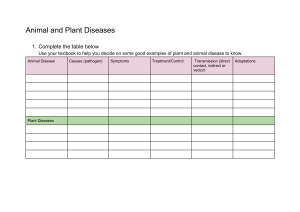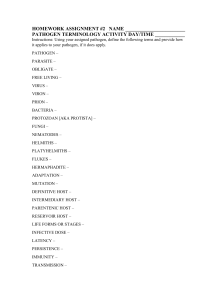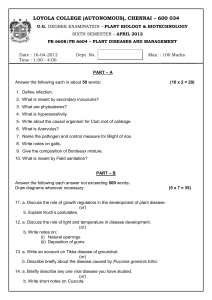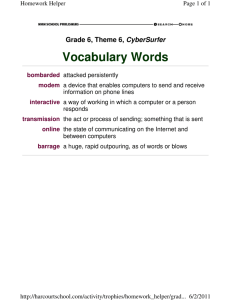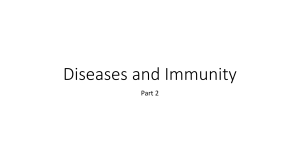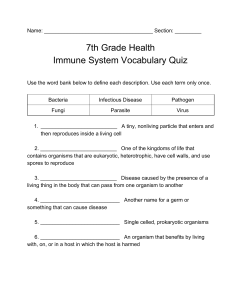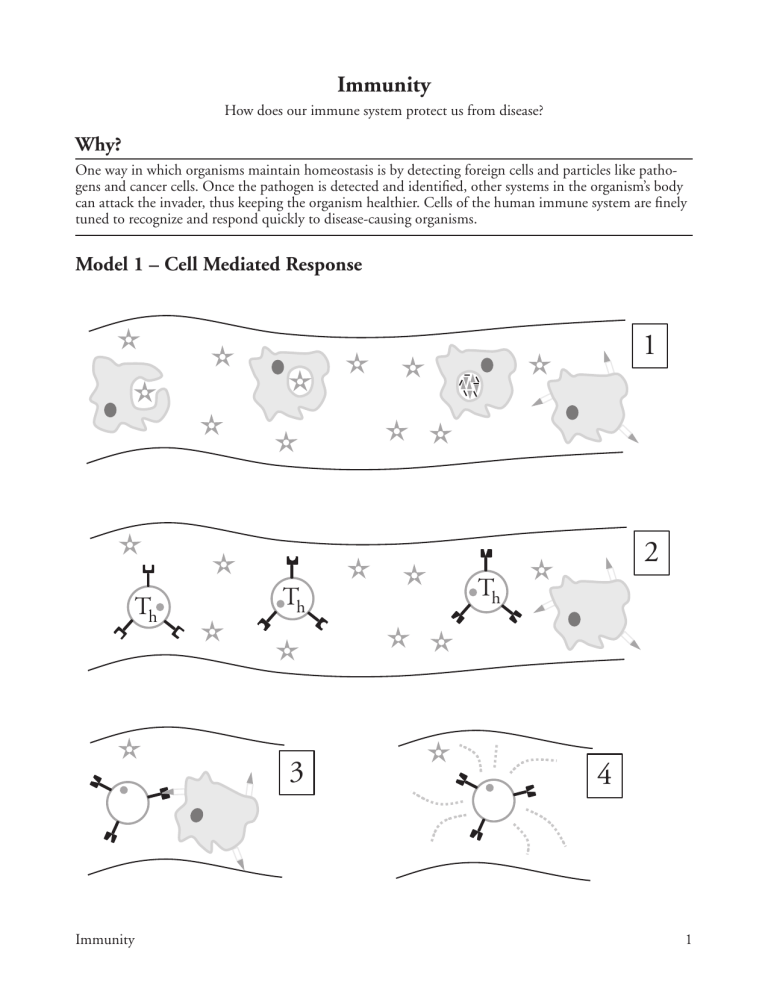
Immunity How does our immune system protect us from disease? Why? One way in which organisms maintain homeostasis is by detecting foreign cells and particles like pathogens and cancer cells. Once the pathogen is detected and identified, other systems in the organism’s body can attack the invader, thus keeping the organism healthier. Cells of the human immune system are finely tuned to recognize and respond quickly to disease-causing organisms. Model 1 – Cell Mediated Response 1 2 Th Th 3 Immunity Th 4 1 1. In Model 1 a pathogen (virus, bacteria, foreign protein, parasite) has entered the bloodstream of an individual. Draw the symbol that represents the pathogen. 2. One response of the human immune system is endocytosis of a pathogen by a phagocyte (a type of white blood cell). Refer to Model 1. a. Which diagram in the cell mediated response illustration shows this process? b. Draw the symbol that represents the phagocyte. 3. Another type of white blood cell that is involved in the cell mediated response is a helper T-cell. a. Draw the symbol that represents the helper T-cell in Model 1. b. In your drawing above, circle the specialized surface proteins on the helper T-cell. 4. According to Model 1, are all helper T-cells the same? Justify your answer with specific evidence from Model 1. 5. The following statements are labels for the cell mediated process in Model 1. • • • • ____ A piece of the pathogen is presented on the surface of the phagocyte. ____ The helper T-cell disperses a chemical signal to activate other immune response systems. ____ The helper T-cell binds to the piece of pathogen presented on the phagocyte. ____ Pathogen is broken apart by chemicals in the phagocyte. a. Determine the order of the statements by referring to Model 1. b. With your group, decide where each statement belongs in the diagram and label Model 1 appropriately. Note that more than one statement may match a diagram and some diagrams may not match any statement. 6. According to Model 1, do the helper T-cells interact with the free pathogens in the blood? 2 POGIL™ Activities for AP* Biology Read This! The pieces of pathogen that are presented on the surface of a cell are called antigens. Cells that present antigens on their surface, such as the phagocyte in Model 1, are called antigen-presenting cells (APC). They activate helper T-cells. After being activated by an antigen, the helper T-cell will begin a phase of rapid cell division. The resulting daughter cells may be effector Th cells or memory Th cells. The memory Th cells will stay in the body for several years, ready to respond to the pathogen if it should ever infiltrate the body again. 7. Do all types of helper T-cells bind to all antigens? Justify your answer with specific evidence from Model 1. 8. Add labels to Model 1 for the “antigen” and “antigen-presenting cell.” Model 2 – Humoral Response 1 B Immunity B B 2 3 4 5 3 9. B-cells are a third type of white blood cell that is involved in immunity. a. Draw the symbol that represents a B-cell in Model 2. b. What is the name of the immune system response that involves B-cells? 10. According to Model 2, are all B-cells the same? Justify your answer with specific evidence from Model 2. 11. In diagram 2 of Model 2, binding occurs between an antigen and a B-cell. How is this interaction different from the binding that occurs between antigens and helper T-cells? 12. Consider diagrams 3–5 in Model 2. Write descriptions similar to those in Question 5 for each of these steps in the humoral response. 13. Is a B-cell an antigen-presenting cell? Justify your reasoning. 14. According to Model 2, do B-cells ever interact with pathogens that have infected a cell? Justify your reasoning with specific evidence from Model 2. 15. Predict what would happen if a B-cell like the one shown in diagram 5 of Model 2 were to run into a helper T-cell like the ones in Model 1. 4 POGIL™ Activities for AP* Biology Model 3 – Adaptive Immunity 16. Label the following items in Model 3. Pathogen B-Cell Helper T-cell 17. Describe the interaction between the B-cell and the helper T-cell in Model 3. 18. When a B-cell is activated by the interaction with a helper T-cell it begins to produce and disperse antibodies. a. Draw the symbol that represents an antibody in Model 3. b. According to Model 3, what does the antibody do to pathogens? 19. How might the interaction between the antibody and pathogens affect the pathogen’s ability to infect its host? Read This! After the B-cell is activated by the helper T-cell, the B-cell enters a phase of rapid cell division. Some of the daughter cells become plasma cells that make even more antibody molecules, some reaching a rate of 2,000 molecules per second. The other daughter cells become memory B-cells that will stay in the body for several years, ready to respond to the pathogen if it should ever enter the body again. Immunity 5 Model 4 – Immune Response to a Pathogen 90 Amount of the Antibody Present 80 70 60 50 40 30 20 10 First Encounter with the Pathogen !"0 Time Second Encounter with the Same Pathogen 20. What does the y-axis of the graph in Model 4 represent? 21. How many times did the organism in Model 4 encounter the same pathogen? 22. Using Model 4, compare the amount of the antibody generated by the B-cells after the first encounter with the antigen to the amount of the antibody generated in the second encounter with the antigen. 23. Refer to Model 4. a. Compare the time needed to reach the peak amount of antibody production for the first and second encounters. b. How does your answer to part a explain the fact that we get sick the first time we encounter a virus, but we do not get sick the second time we encounter the same virus? 6 POGIL™ Activities for AP* Biology 24. People who are allergic to bee stings are actually having a response to the antibodies produced by their immune system when they are stung. This is called anaphylaxis. Most people who end up having a bee sting allergy did not have anaphylaxis the first time they were stung. It is only upon the second sting, or subsequent stings that they have an allergic response. Use what you have learned in this activity to explain this phenomenon. 25. Consider all the different types of cells mentioned in this activity that participate in the immune response. Which cells are responsible for the response to the second pathogen exposure illustrated in Model 4? Justify your reasoning. 26. Consider Models 1 and 2, and the interaction that helper T-cells and B-cells have with the pathogen. a. Why is the process in Model 1 called a “cell mediated” response? b. Why is the process in Model 2 called a “humoral” response? Note: Blood was once referred to as one of the humors of the body. Immunity 7 Extension Questions 27. Consider the life cycle of a cell. When the memory cells of the immune system are not activated or responding to a pathogen exposure, what phase of the cell cycle are they likely in? Justify your reasoning. Read This! Edward Jenner, an English country doctor, is credited with giving the first relatively safe vaccine. He noticed that girls who milked cows developed sores on their hands that were similar to the sores of smallpox victims. These sores were called cowpox, but the girls did not seem to be sick and they did not become ill with the dreaded human disease, smallpox. Legend states that Jenner purposely infected a young boy with scrapings from cowpox sores and then exposed the boy to smallpox. The boy did not become ill, and the practice of vaccinations moved rapidly into mainstream medicine. The word vaccination comes from the Latin word for cow, vacca. Today, thanks to intensive vaccination practices in the last half of the 20th century, smallpox is no longer a dreaded human disease. Since then, vaccines for other diseases like polio and measles have been developed, and we no longer have widespread deaths from these diseases. 28. Use what you learned in this activity to explain why the girls observed by Jenner did not get sick from smallpox. 29. Using the information from this activity and the Read This! box, write a definition for the term vaccine, using the terms antigen, antibody, and memory B-cells. 30. The common cold is a viral disease. So is AIDS, which is caused by the Human Immunodeficiency Virus, or HIV. Effective vaccines against these viral diseases have not been developed despite years of research and work by dedicated scientists. One reason for this is the rapid mutation rate of these viruses, leading to new surface proteins in a very short time. Return to Model 2 to speculate about how this rapid change in the cold virus and HIV make vaccinations difficult to develop. 31. Propose a reason why you must get vaccine “booster” shots every few years. 8 POGIL™ Activities for AP* Biology

